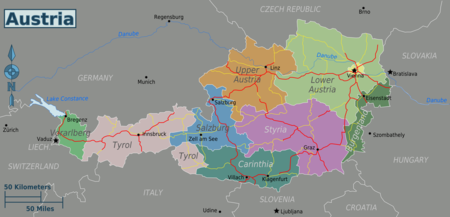![]() Click here to see the map of the area in full screen.
Click here to see the map of the area in full screen.
| Location | |
 | |
| Fast Data | |
| Capital city | Vienna |
| State | Federally Presided Parliamentary Democracy |
| Coin | Euro (€ EUR) |
| Area | 83,871 km2 |
| Population | 8,699,730 (estimate 2016) |
| Language | German |
| Calling Code | 43 |
| Internet TLD | .at and .eu as an EU member. |
| Time zone | (UTC 1) Daylight Saving Time (UTC 2) |
THE Austria (German: Austria) is her country CentralOf Europe. The capital of Austria is Vienna.
At a glance
Appropriate visit period
November - March
Languages
The official language of Austria is German.
Areas
Important cities
- Vienna (German: Vienna) —
- Bregenz (German: Bregenz) —
- Eisenstadt (German: Eisenstadt, Hungarian: Kismarton) —
- Graz (German: Graz) —
- Innsbruck (German: Innsbruck) —
- Klagenfurt (German: Klagenfurt am Wörthersee, Slovenian: Celovec ob Vrbskem jezeru) —
- Leeds (German: Linz, Czech: Linec) —
- Salzburg[and Hellenized Salzburg (German: Salzburg) —
- Φιλλαχ (German: Villach) —
Additional tourist destinations
- Lake Constantia -
- Hallstatt (German: Hallstatt) - Picturesque village on the shore of the homonymous lake. It is a UNESCO World Heritage Site.
How to get there
 By air
By air
 By train
By train

High speed trains Railjet connect the Budapest with the Zurich and Frankfurt via Βιέννης. Another line goes by Prague in the Φιλλαχ and will arrive soon Venice. Information at web page of the Austrian Rail transport.
 By road
By road
 By boat
By boat
How to move
To use the Austrian motorways you must purchase the one-year toll sticker (Mautvignette). Additional tolls are paid on alpine roads and so-called special toll roads
What to see
Entertainment
Transactions and purchases
Cost
Austria uses euro. It is one of the many European countries that use the single currency. All euro banknotes and coins are legal tender in all countries that use them.
Countries that have the euro as their official currency:
|
The euro is divided into 100 cents.
The official symbol of the euro is €, and the ISO code is EUR. There is no official symbol of the euro cents.
- Banknotes: Euro banknotes have the same design in all countries.
- Regular coins: All euro countries issue euro coins with a typical national design on one side and a common design on the other. The coins can be used in any Eurozone country, regardless of the design they depict. (eg a one euro coin from Finland can be used in Portugal).
- Commemorative coins of two euros: These differ from regular two euro coins on their "national" side, and are legally traded. Each country can mint a certain number of them, and sometimes "pan-European" two-euro commemorative coins are minted for important events (eg the anniversary of an important treaty).
- Other commemorative coinsCommemorative coins of other denominations (eg ten euros or more) are rarer, and have a special design, often containing some gold, silver or platinum. While they are technically a legal medium of exchange, their collectible value is greater than their face value, and you are therefore unlikely to find them in the everyday market.
Local cuisine
Local drinks
Tourist infrastructure
Studies
Job opportunities
Stay safe
Health and precautions
Tick-borne encephalitis (ENT) is widespread inland.


